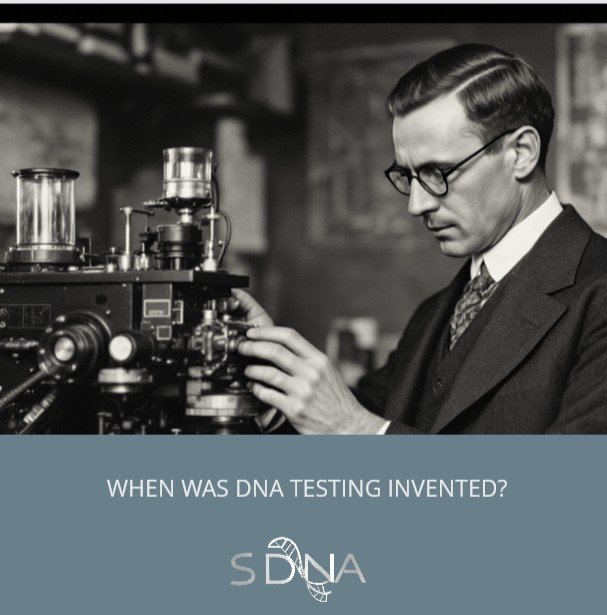
When Was DNA Testing Invented?
DNA testing was invented in the early 1980s when DNA fingerprinting techniques were first developed. Modern DNA testing emerged specifically in 1984 when British geneticist Alec Jeffreys discovered unique patterns in DNA that could identify individuals. The technology evolved rapidly with the introduction of Polymerase Chain Reaction (PCR) in 1983 and Short Tandem Repeat (STR) analysis in the 1990s.
Earlier scientific discoveries laid the groundwork for these breakthroughs, starting with Friedrich Miescher’s identification of “nuclein” (DNA) in 1869. The progression from early blood-typing methods to advanced genetic analysis transformed multiple fields including criminal justice, medical diagnostics, paternity verification, and ancestry research.
Early Discoveries Related to DNA
Foundational discoveries about DNA include:
- 1869: Friedrich Miescher identified “nuclein,” later known as DNA, though its hereditary role was unknown at the time.
- Early 1900s: Phoebus Levene discovered nucleotides composed of phosphate, sugar, and nitrogen bases.
- 1950: Erwin Chargaff established that DNA composition varies by species, formulating Chargaff’s Rules where adenine pairs with thymine and guanine pairs with cytosine.
Early Paternity Testing and Media Influence
Before DNA analysis, early methods helped in paternity cases:
- Early to mid-20th century: Blood typing (e.g., ABO system) could exclude men as fathers but could not confirm paternity.
- 1940s: The Joan Barry vs. Charlie Chaplin case involved blood typing evidence; courts were often skeptical of such scientific testimony.
Interest in genealogical and paternity testing actually dates back to the 1920s, coinciding with an era fascinated by eugenics and racial pseudoscience. Early testing methods ranged from rudimentary blood typing to pseudoscientific devices like Dr. Albert Abrams’ oscillophore—a machine claimed to detect ancestry by measuring blood vibrations.
The media played a crucial role in transforming paternity testing into a cultural phenomenon. Sensational press coverage of high-profile paternity disputes helped bring these scientific methods into public conversation, often emphasizing scandalous elements like divorce and adultery. Newspapers frequently exaggerated or distorted scientific claims, sometimes suggesting that courts had fully validated even unreliable testing methods.
Transition to Modern DNA Testing Techniques
The invention of actual DNA testing as it is known today came with the development of specific molecular techniques in the late 20th century. The introduction of Polymerase Chain Reaction (PCR) in the 1980s allowed for the amplification of small DNA samples. Later, Short Tandem Repeat (STR) analysis became the standard for forensic and paternity testing due to its high accuracy in distinguishing individuals.
In the early 1980s, DNA fingerprinting emerged as a powerful new tool for identifying individuals and confirming parentage. While initial legal acceptance was cautious, media coverage quickly granted the new technology widespread public legitimacy—following a pattern similar to earlier media treatment of less reliable tests.
These advancements marked the true beginning of modern DNA testing, enabling precise genetic profiling that transformed legal cases, medical diagnostics, and ancestry research.
The Modern DNA Testing Landscape
DNA testing has since become standard in forensic science and has spawned a multi-billion dollar commercial ancestry industry. The year 2017 marked a particular milestone when consumer DNA testing experienced explosive growth, with more home testing kits sold than in all previous years combined—a surge attributed to both scientific progress and the emergence of a direct-to-consumer genetic testing industry over the previous two decades.
Media partnerships with biotech companies have fueled popular “who’s your daddy” TV shows, promoting genetic testing as both authoritative and entertaining. The public remains captivated by DNA testing’s ability to reveal intimate family secrets, uncover unknown relatives, and reshape personal identity narratives.
Today, approximately 1 in 25 Americans has undergone DNA testing, reflecting its deep integration into contemporary culture. This widespread adoption demonstrates how a technology that began with foundational scientific discoveries in the 19th century has evolved into a powerful tool that shapes our understanding of identity, health, and family relationships.
Summary:
While foundational discoveries about DNA began in the late 19th and early 20th centuries, DNA testing as a practical and reliable tool was invented much later with the advent of PCR and STR methods in the 1980s and beyond. This timeline highlights how scientific progress gradually led to the powerful DNA testing technologies used today, while media influence helped transform these scientific developments into cultural phenomena with far-reaching implications.c progress gradually led to the powerful DNA testing technologies used today.
Paternal Services:
Home Paternity Test
Legal Paternity Test
Prenatal Paternity Test
Parentage DNA Testing
DNA Testing Services:
Sibling DNA Test
Grandparent DNA Test
Avuncular DNA Test
Maternity DNA Test
Forensic DNA Services:
Infidelity DNA Test
DNA Testing w/Hair
DNA Testing w/Toothbrush
